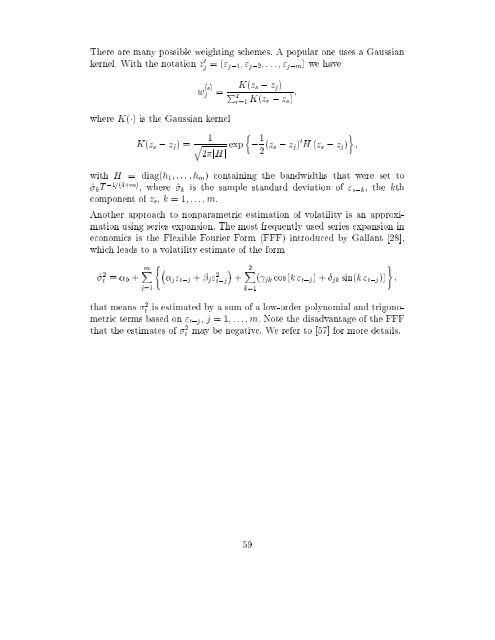Estimation in Financial Models - RiskLab
Estimation in Financial Models - RiskLab
Estimation in Financial Models - RiskLab
You also want an ePaper? Increase the reach of your titles
YUMPU automatically turns print PDFs into web optimized ePapers that Google loves.
There are many possible weight<strong>in</strong>g schemes. A popular one uses a Gaussian<br />
kernel. With the notation z 0 j =(" j,1 ;" j,2 ;:::;" j,m )we have<br />
w (s)<br />
j =<br />
where K() istheGaussian kernel<br />
K(z s , z j )=<br />
1<br />
q<br />
2jHj<br />
exp<br />
K(z s , z j )<br />
P Tr=1<br />
K(z r , z s ) ;<br />
<br />
, 1 <br />
2 (z s , z j ) 0 H (z s , z j ) ;<br />
with H = diag(h 1 ;:::;h m ) conta<strong>in</strong><strong>in</strong>g the bandwidths that were set to<br />
^ k T ,1=(4+m) , where ^ k is the sample standard deviation of " s,k , the kth<br />
component of z s , k =1;:::;m.<br />
Another approach to nonparametric estimation of volatility is an approximation<br />
us<strong>in</strong>g series expansion. The most frequently used series expansion <strong>in</strong><br />
economics is the Flexible Fourier Form (FFF) <strong>in</strong>troduced by Gallant [28],<br />
which leads to avolatility estimate of the form<br />
( mX j <br />
)<br />
2X<br />
^ t 2 = 0 + " t,j + j " 2 t,j + ( jk cos(k" t,j )+ jk s<strong>in</strong>(k" t,j )) ;<br />
j=1<br />
k=1<br />
that means t 2 is estimated by a sum of a low-order polynomial and trigonometric<br />
terms based on " t,j , j =1;:::;m. Note the disadvantage of the FFF<br />
that the estimates of t<br />
2 may benegative. We refer to [57] for more details.<br />
59
















